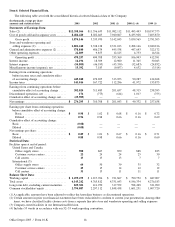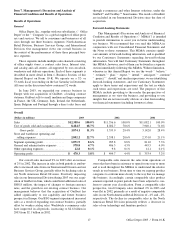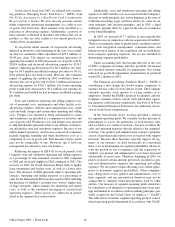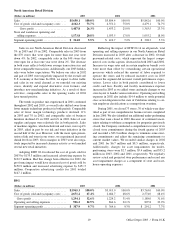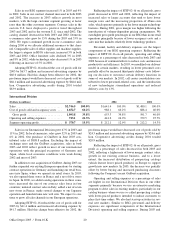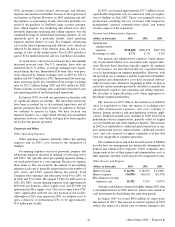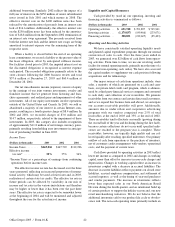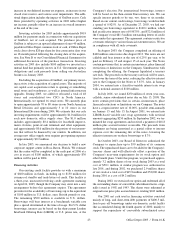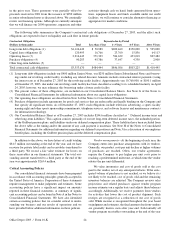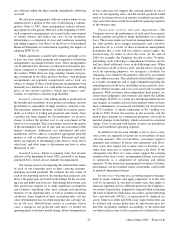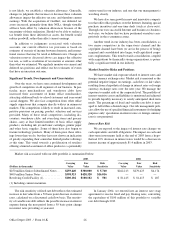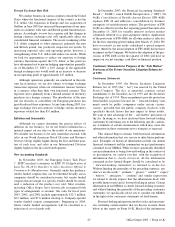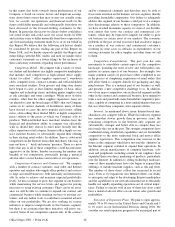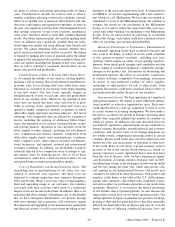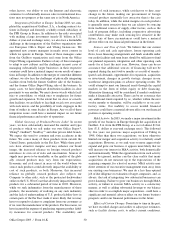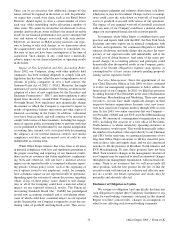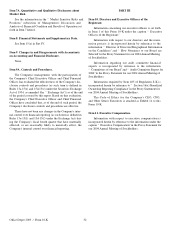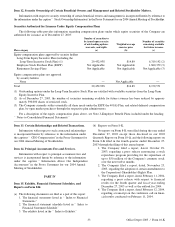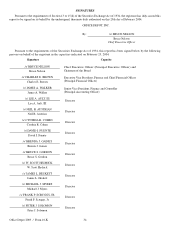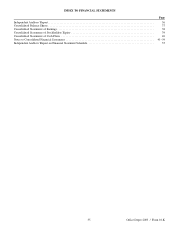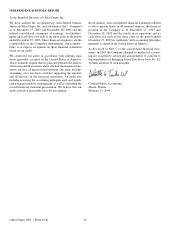Office Depot 2003 Annual Report Download - page 28
Download and view the complete annual report
Please find page 28 of the 2003 Office Depot annual report below. You can navigate through the pages in the report by either clicking on the pages listed below, or by using the keyword search tool below to find specific information within the annual report.
Office Depot 2003 / Form 10-K 26
is not likely, we establish a valuation allowance. Generally,
changes in judgments that increase or decrease these valuation
allowances impact the effective tax rate, and therefore current
earnings. With the acquisition of Guilbert, our deferred tax
assets increased, primarily from their NOLs, though virtually
all have been offset by valuation allowances because of the
uncertainty of their realization. Should we be able to realize a
tax benefit from these deferred tax assets, the benefit would
reduce goodwill, rather than affect current earnings.
In addition to judgments associated with valuation
accounts, our current effective tax provision is based on
estimates of our mix of income between domestic and interna-
tional sources that may be taxed at different rates. Changes in
valuation reserves discussed above can impact the effective
tax rate, as well as resolution of tax matters at amounts other
than what we estimated. We regularly monitor our current and
deferred tax positions and reflect our best estimates of events
that have an uncertain outcome.
Significant Trends, Developments and Uncertainties
Over the years, we have seen continued development and
growth of competitors in all segments of our business. In par-
ticular, mass merchandisers and warehouse clubs have
increased their assortment of home office merchandise,
attracting additional back-to-school customers and year-round
casual shoppers. We also face competition from other office
supply superstores that compete directly with us in numerous
markets. This competition is likely to result in increased com-
petitive pressures on pricing, product selection and services
provided. Many of these retail competitors, including dis-
counters, warehouse clubs, and even drug stores and grocery
chains, carry at least limited numbers of basic office supply
products, including ink jet and toner cartridges, printer paper
and other basic supplies. Some of them have also begun to
feature technology products. Many of them price these offer-
ings lower than we do, but they have not shown an indication
of greatly expanding their somewhat limited product offerings
at this time. This trend towards a proliferation of retailers
offering a limited assortment of office products is a potentially
serious trend in our industry, and one that our management is
watching closely.
We have also seen growth in new and innovative competi-
tors that offer office products over the Internet, featuring special
purchase incentives and one-time deals (such as close-outs).
Through our own successful Internet and business-to-business
web sites, we believe that we have positioned ourselves com-
petitively in the e-commerce arena.
Another trend in our industry has been consolidation, as
two major competitors in the superstores channel and the
copy/print channel have been (or are in the process of being)
acquired and consolidated into larger, well-capitalized corpo-
rate conglomerates. This trend towards consolidation, coupled
with acquisitions by financially strong organizations, is poten-
tially a significant trend in our industry.
Market Sensitive Risks and Positions
We have market risk exposure related to interest rates and
foreign currency exchange rates. Market risk is measured as the
potential negative impact on earnings, cash flows or fair values
resulting from a hypothetical change in interest rates or foreign
currency exchange rates over the next year. We manage the
exposure to market risks at the corporate level. The portfolio of
interest-sensitive assets and liabilities is monitored and adjusted
to provide liquidity necessary to satisfy anticipated short-term
needs. The percentage of fixed and variable rate debt is man-
aged to fall within a desired range. Our risk management poli-
cies allow the use of specified financial instruments for hedging
purposes only; speculation on interest rates or foreign currency
rates is not permitted.
Interest Rate Risk
We are exposed to the impact of interest rate changes on
cash equivalents and debt obligations. The impact on cash and
short-term investments held at the end of 2003 from a hypo-
thetical 10% decrease in interest rates would be a decrease in
interest income of approximately $1.4 million in 2003.
Market risk associated with our debt portfolio is summarized below:
2003 2002
Carrying Fair Risk Carrying Fair Risk
(Dollars in thousands) Value Value Sensitivity Value Value Sensitivity
$250 million Senior Subordinated Notes. . . . $259,440 $300,000 $ 5,760 $262,213 $279,625 $6,174
$400 million Senior Notes . . . . . . . . . . . . . . . $398,923 $420,320 $16,016 ———
Revolving Credit Facility (1) . . . . . . . . . . . . . $100,102 $100,102 $ 501 $ 81,415 $ 81,415 $ 407
(1) Including current maturities.
The risk sensitivity of fixed rate debt reflects the estimated
increase in fair value from a 50 basis point decrease in interest
rates, calculated on a discounted cash flow basis. The sensitiv-
ity of variable rate debt reflects the possible increase in interest
expense during the next period from a 50 basis point change
in interest rates prevailing at year-end.
In January 2004, we entered into an interest rate swap
agreement to receive fixed and pay floating rates, converting
the equivalent of $100 million of this portfolio to variable
rate debt through 2013.


